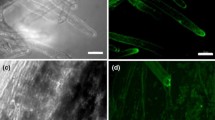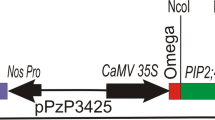Abstract
Aquaporins seem essential for the regulation of plant water status and expenses. Richter-110 is a Vitis hybrid (Vitis berlandieri × rupestris) reputed to be strongly drought-tolerant. Three irrigation treatments were established in Richter-110 plants growing outdoors defined by the resulting maximum stomatal conductance (g s), and ensuring water stress situations not severe enough as to stop photosynthesis and growth: well-watered plants (g s about 250 mmol H2O m−2 s−1), moderate water stress (g s about 150 mmol H2O m−2 s−1) and severe water stress (g s about 50 mmol H2O m−2 s−1). Plants under water stress were kept at constant water availability for 7 days to check for possible acclimation. Finally, plants were re-watered, and allowed to recover, for 3 days. Stomatal conductance, leaf water potential, xylem abscisic acid (ABA) content and root and stem hydraulic conductivity were determined. The relative amounts of expression of mRNA encoding seven putative aquaporins were determined in roots and leaves by RT-PCR. The decrease in stomatal conductance with moderate and severe water stress was associated with increasing ABA contents, but not with the leaf water potential and hydraulic conductivities, which remained unchanged during the entire experiment. Aquaporin gene expression varied depending on which aquaporin, water stress level and the plant organ. We suggest that aquaporin expression was responsive to water stress as part of the homeostasis, which resulted in constant leaf water potential and hydraulic conductivity.



Similar content being viewed by others
Abbreviations
- ABA:
-
Abscisic acid
- AQP:
-
Aquaporin
- MIP:
-
Major intrinsic protein
- g s :
-
Stomatal conductance
- PIP:
-
Plasma membrane intrinsic protein
- PLC:
-
Percentage of loss conductivity
- RWC:
-
Leaf relative water content
- TIP:
-
Tonoplast intrinsic protein
- Ψ:
-
Leaf water potential
References
Aharon R, Shahak Y, Wininger S, Bendov R, Kapulnik Y, Galili G (2003) Overexpression of plasma membrane aquaporin in transgenic tobacco improves plant vigor under favorable growth conditions but not under drought or salt stress. Plant Cell 15:439–447
Alexandersson E, Fraysse L, Sjövall-Larsen S, Gustavsson S, Fellert M, Karlsson M, Johanson U, Kjellbom P (2005) Whole gene family expression and drought stress regulation of aquaporins. Plant Mol Biol 59:469–484
Baiges I, Schäffner AR, Mas A (2001) Eight cDNA encoding putative in Vitis hybrid Richter-110 and their differential expression. J Exp Bot 52:1949–1951
Boyer JS (1982) Plant productivity and environment. Science 218:443–448
Chaves MM (1991) Effects of water deficits on carbon assimilation. J Exp Bot 42:1–16
Chaves MM, Oliveira MM (2004) Mechanisms underlying plant resilience to water deficits: prospects for water-saving agriculture. J Exp Bot 55:2365–2384
Chaves MM, Maroco JP, Pereira JS (2003) Understanding plant responses to drought—from genes to the whole plant. Funct Plant Biol 30:239–264
Clarkson DT, Carvajal M, Henzler T, Waterhouse RN, Smith AJ, Cooke DT, Steudle E (2000) Root hydraulic conductance: diurnal aquaporin expression and the effects of nutrient stress. J Exp Bot 51:61–70
Comstock JP, Mencuccini M (1998) Control of stomatal conductance by leaf water potential in Hymenoclea salsola (T&G.), a desert subshrub. Plant Cell Environ 21:1029–1038
Conroy JP, Virgona JM, Smillie RM, Barlow EW (1988) Influence of drought acclimation and CO2 enrichment on osmotic adjustment and chlorophyll a fluorescence of sun-flower during drought. Plant Physiol 86:1108–1115
Doyle JJ, Doyle JL (1987) A rapid DNA isolation procedure for small quantities of fresh leaf tissue. Phytochem Bull 19:11–15
Flexas J, Bota J, Escalona JM, Sampol B, Medrano H (2002) Effects of drought on photosynthesis in grapevines under field conditions: an evaluation of stomatal and mesophyll limitations. Funct Plant Biol 29:461–471
Flexas J, Bota J, Loreto F, Cornic G, Sharkey TD (2004) Diffusive and metabolic limitations to photosynthesis under drought and salinity in C3 plants. Plant Biol 6:269–279
Flexas J, Bota J, Galmés J, Medrano H, Ribas-Carbó M (2006a) Keeping a positive carbon balance under adverse conditions: responses of photosynthesis and respiration to water stress. Physiol Plant 127:343–352
Flexas J, Ribas-Carbó M, Hanson DT, Bota J, Otto B, Cifre J, McDowell N, Medrano H, Kaldenhoff R (2006b) Tobacco aquaporin NtAQP1 is involved in mesophyll conductanve to CO2 in vivo. Plant J. doi:10.1111/j.1365-313X.2006.02879.x
Galet P (1988) Cépages et vignobles de France. In: Tome I (ed) Les vignes américaines, 2eme edn. Imprimerie Charles Déhan, Montpellier
Hanba YT, Shibasaka M, Hayashi Y, Hayakawa T, Kasamo K, Terashima I, Katsuhara M (2004) Overexpression of the barley aquaporin HvPIP2;1 increases internal CO2 conductance and CO2 assimilation in the leaves of transgenic rice plants. Plant Cell Physiol 45:521–529
Henzler T, Waterhouse RN, Smyth AJ, Carvajal M, Cooke DT, Schäffner AR, Steudle E, Clarkson DT (1999) Diurnal variations in hydraulic conductivity and root pressure can be correlated with the expression of putative aquaporins in the roots of Lotus japonicus. Planta 210:50–60
Holbrook NM, Zwieniecki MA (1999) Embolism repair and xylem tension. Do we need a miracle? Plant Physiol 120:7–10
Hsiao TC (1973) Plant responses to water stress. Ann Rev Plant Physiol 24:519–570
Jang JK, Kim DG, Kim YO, Kim JS, Kang H (2004) An expression analysis of a gene family encoding plasma membrane aquaporins in response to abiotic stresses in Arabidopsis thaliana. Plant Mol Biol 54:713–725
Johansson I, Larsson C, Ek B, Kjellbom P (1996) The major integral proteins of spinach leaf plasma membranes are putative aquaporins and are phosphorylated in response to Ca2+ and apoplastic water potential. Plant Cell 8:1181–1191
Johansson I, Karlsson M, Shukla VK, Chrispeels MJ, Larsson C, Kjellbom P (1998) Water transport activity of the plasma membrane aquaporin PM28A is regulated by phosphorylation. Plant Cell 10:451–459
Jones MM, Turner NC, Osmond CB (1981) Mechanisms of drought resistance. In: Paleg LG, Aspinall D (eds) Physiology and biochemistry of drought resistance in plants. Academic, Sydney, pp 15–37
Kaldenhoff R, Grote K, Zhu JJ, Zimmermann U (1998) Significance of plasmalemma aquaporins for water-transport in Arabidopsis thaliana. Plant J 14:121–128
Kawasaki S, Borchert C, Deyholos M, Wang H, Brazille S, Kawai K, Galbraith D, Bohnert HJ (2001) Gene expression profiles during the initial phase of salt stress in rice. Plant Cell 13:889–905
Kirch HH, Vera-Estrella R, Golldack D, Quigley F, Michalowski CB, Barkla BJ, Bohnert HJ (2000) Expression of water channel proteins in Mesembryanthemum crystallinum. Plant Physiol 123:111–124
Lawlor DW, Cornic G (2002) Photosynthetic carbon assimilation and associated metabolism in relation to water deficits in higher plants. Plant Cell Environ 25:275–294
Li L, Li S, Tao Y, Kitagawa Y (2000) Molecular cloning of a novel water channel from rice: its products expression in Xenopus oocytes and involvement in chilling tolerance. Plant Sci 154:43–51
Livak KJ, Schmittgen TD (2001) Analysis of relative gene expression data using real-time quantitative PCR and the 2−ΔΔC T method. Methods 25:402–408
Lovisolo C, Hartung W, Schubert A (2002) Whole-plant hydraulic conductance and root-to-shoot flow of abscisic acid are independently affected by water stress in grapevines. Funct Plant Biol 29:1349–1356
Luu DT, Maurel C (2005) Aquaporins in a challenging environment: molecular gears for adjusting plant water status. Plant Cell Environ 28:85–96
Maathuis FJM, Filatov V, Herzyk P, Krijger GC, Axelsen KB, Chen S, Green BJ, Li Y, Madagan KL, Sánchez-Fernández R, Forde BG, Palmgren MG, Rea PA, Williams LE, Sanders D, Amtmann A (2003) Transcriptome analysis of root transporters reveals participation of multiple gene families in the response to cation stress. Plant J 35:675–692
Maurel C, Chrispeels M, Lurin C, Tacnet F, Geelen D, Ripoche P, Guern J (1997) Function and regulation of seed aquaporins. J Exp Bot 48:421–430
North GB, Martre P, Nobel PS (2004) Aquaporins account for variations in hydraulic conductance for metabolically active root regions of Agave deserti in wet, dry, and rewetted soil. Plant Cell Environ 27:219–228
Ranathunge K, Kotula L, Steudle E, Lafitte R (2004) Water permeability and reflection coefficient of the outer part of young rice roots are differently affected by closure of water channels (aquaporins) or blockage of apoplastic pores. J Exp Bot 55:433–447
Schultz HR (2003) Differences in hydraulic architecture account for near isohydric and anisohydric behaviour of two field-grown Vitis vinifera L. cultivars under drought. Plant Cell Environ 26:1393–1405
Secchi F, Lovisolo C, Uehlein N, Kaldenhoff R, Schubert A (2006) Isolation and functional characterization of three aquaporins from olive (Olea europaea L.) Planta. doi:10.1007/s00425-006-0365-2
Siefritz F, Tyree MT, Lovisolo C, Schubert A, Kaldenhoff R (2002) PIP1 plasma membrane aquaporins in tobacco: from cellular effects to function in plants. Plant Cell 14:869–876
Smart LB, Moskal WA, Cameron KD, Bennett AB (2001) MIP genes are down-regulated under drought stress in Nicotiana glauca. Plant Cell Physiol 42:686–693
Sperry JS, Hacke UG, Oren R, Comstock JP (2002) Water deficits and hydraulic limits to leaf water supply. Plant Cell Environ 25:251–263
Steudle E (1994) Water transport across roots. Plant Soil 167:79–90
Steudle E, Peterson CA (1998) How does water get through roots? J Exp Bot 49:775–788
Steudle E, Murrmann M, Peterson CA (1993) Transport of water and solutes across maize roots modified by puncturing the endodermis. Further evidence for the composite transport model of the root. Plant Physiol 103:335–349
Tardieu F, Simmonneau T (1998) Variability among species of stomatal control under fluctuating soil water status and evaporative demand: modelling isohydric and anisohydric behaviours. J Exp Bot 49:419–432
Tournaire-Roux C, Sutka M, Javot H, Gout E, Gerbeau P, Luu DT, Bligny R, Maurel C (2003) Cytosolic pH regulates root water transport during anoxic stress through gating of aquaporins. Nature 425:393–397
Tyerman SD, Niemietz CM, Bramley H (2002) Plant aquaporines: multifunctional water and solute channels with expanding roles. Plant Cell Environ 25:173–194
Tyree MT, Salleo S, Nardini A, Lo Gullo MA, Mosca R (1999) Refilling of embolized vessels in young stems of laurel. Do we need a new paradigm? Plant Physiol 120:11–21
Uehlein N, Lovisolo C, Siefritz F, Kaldenhoff R (2003) The tobacco aquaporin NtAQP1 is a membrane CO2 transporter with physiological functions. Nature 425:734–737
Vera-Estrella R, Barkla BJ, Bohnert HJ, Pantoja O (2004) Novel regulation of aquaporins during osmotic stress. Plant Physiol 135:2318–2329
Weig A, Deswarte C, Chrispeels MJ (1997) The major intrinsic protein fanily of Arabidopsis has 23 members that form three distinct groups with functional aquaporins in each group. Plant Physiol 114:550–555
Yamada S, Komori T, Myers PN, Kuwata S, Kubo T, Imaseki H (1997) Expression of plasma membrane water channel genes under water stress in Nicotiana excelsior. Plant Cell Physiol 38:1226–1231
Yamaguchi K, Koizumi M, Urao S, Shinozaki K (1992) Molecular cloning and characterization of 9 cDNAs for genes that are responsive to desiccation in Arabidopsis thaliana: sequence analysis of one cDNA clone encodes a putative transmembrane channel protein. Plant Cell Physiol 33:217–224
Acknowledgments
This study was financed by the Spanish Ministry of Education and Research—projects BFU2005-03102/BFI “Effects of drought on photosynthesis and respiration: acclimation and recovery” and AGL2005-06927-CO2-01/AGR “Optimización del uso del agua en la vid: Regulación y control fisiológico y agronómico y efectos en la calidad del fruto”. Dr. Felicidad De Herralde (IRTA, Spain), Drs A Mas and I Baiges (Universitat Rovira i Virgili, Spain) and Dr Josefina Bota (Universitat de les Illes Balears, Spain) are acknowledged for help in the establishment of methodologies. We are indebted to Dr JM Martínez-Zapater (CNB-CSIC, Spain) for his helpful advices on molecular biology. Drs C Lovisolo (University of Torino, Italy) and AJ Keys (Rothamsted Research, UK) are also acknowledged for stimulating discussion on previous versions of the manuscript.
Author information
Authors and Affiliations
Corresponding author
Rights and permissions
About this article
Cite this article
Galmés, J., Pou, A., Alsina, M.M. et al. Aquaporin expression in response to different water stress intensities and recovery in Richter-110 (Vitis sp.): relationship with ecophysiological status. Planta 226, 671–681 (2007). https://doi.org/10.1007/s00425-007-0515-1
Received:
Accepted:
Published:
Issue Date:
DOI: https://doi.org/10.1007/s00425-007-0515-1




